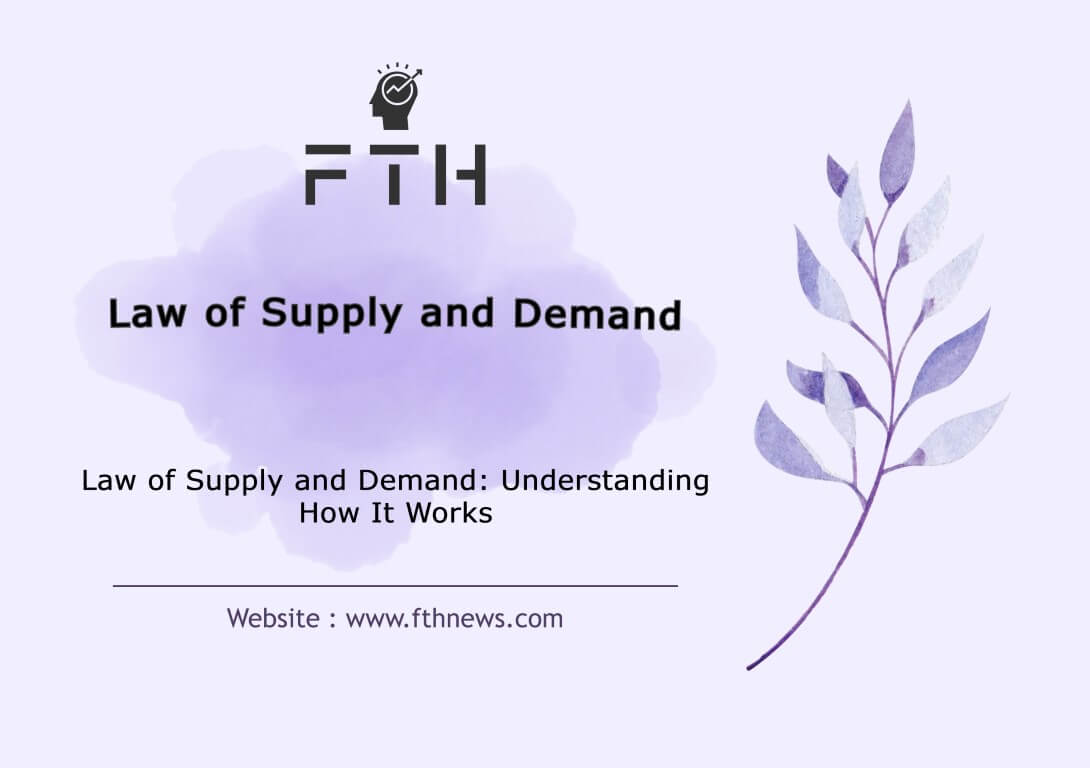
The Law of Supply and Demand is a fundamental economic principle that describes the relationship between the availability (supply) of a product or service and the desire for that product or service (demand) in a competitive market. It serves as the cornerstone of market dynamics, influencing prices and quantities in various industries. The law is based on a few key premises:
Inverse Relationship: At its core, the Law of Supply and Demand suggests an inverse relationship between price and quantity. When the price of a good or service rises, the quantity demanded typically decreases, and when the price falls, the quantity demanded generally increases.
Direct Relationship: Conversely, there is a direct relationship between the price of a good or service and the quantity supplied. When prices rise, suppliers are more willing to produce and offer more of that good or service in the market. When prices fall, suppliers may reduce the quantity they are willing to provide.
To understand this law better, it can be broken down into two main components:
The Law of Demand:
The Law of Demand focuses on the behavior of consumers. It posits that all other factors being equal (ceteris paribus), as the price of a product or service decreases, the quantity demanded for that product or service increases, and vice versa. In simpler terms, people tend to buy more of a product when it becomes more affordable, and they buy less of it when prices rise.
This concept is often illustrated using a demand curve, which slopes downward from left to right, representing the negative relationship between price and quantity demanded. It’s a foundational idea for businesses to understand how to set prices that consumers will be willing to pay.
The Law of Supply:
The Law of Supply focuses on the behavior of producers or suppliers. It states that, under ceteris paribus conditions, an increase in the price of a good or service leads to an increase in the quantity supplied, while a decrease in price results in a decrease in quantity supplied. This reflects the idea that businesses are more inclined to produce and sell more of a product when prices are high, as it offers a better return on their investment.
The supply curve, which is graphically depicted, slopes upwards from left to right, illustrating the positive relationship between price and quantity supplied. This concept is crucial for businesses and producers to make decisions regarding production levels and pricing strategies.
In summary, the Law of Supply and Demand is a fundamental economic principle that plays a vital role in shaping market dynamics. It is a fundamental concept for businesses, consumers, economists, and policymakers, as it provides insights into how prices are determined and how resources are allocated in a market economy. Understanding this law is essential for making informed decisions in the world of economics and commerce.
Why Is the Law of Supply and Demand Important?
Now that we’ve covered the basics, let’s explore the profound significance of the Law of Supply and Demand:
Price Determination:
The Law of Supply and Demand serves as the invisible hand that guides the economy. It plays a fundamental role in determining equilibrium prices. Equilibrium is the point at which the quantity demanded equals the quantity supplied. In other words, it’s the price at which the market naturally finds a balance between what consumers are willing to pay and what producers are willing to supply. This equilibrium ensures that goods and services are priced fairly and efficiently, reflecting the true value they hold in the market.
Market Efficiency:
This law fosters economic efficiency by ensuring that resources are allocated optimally. When supply and demand are in balance, it helps prevent both shortages and surpluses. For businesses, understanding the Law of Supply and Demand is essential for making informed decisions about production levels. By monitoring market conditions and consumer preferences, they can gauge when to produce more or less to meet the ever-changing demands of their target audience.
Economic Forecasting:
Economists and policymakers heavily rely on the Law of Supply and Demand as a powerful tool for economic forecasting. By analyzing supply and demand trends, they can gain insights into the overall health of an economy and make informed decisions about monetary and fiscal policies. Understanding how changes in demand and supply affect various industries can help predict economic conditions and develop strategies to address potential challenges or opportunities.
Investment Decisions:
Investors use the Law of Supply and Demand to assess the potential profitability of various assets. A strong demand for a particular product or service may signify a lucrative investment opportunity, as it suggests a potential for higher returns. On the other hand, a market characterized by oversupply and weak demand may indicate the need for diversification or reevaluating investment choices. By monitoring these market dynamics, investors can make more informed decisions regarding their portfolios.
Consumer Empowerment:
Understanding the Law of Supply and Demand empowers consumers to make informed choices in the marketplace. When consumers grasp the principles behind this law, they can effectively compare prices and quality across different brands or products. This knowledge allows them to make rational purchasing decisions, ensuring they receive the best value for their money. Consumer awareness can also influence market behavior, as businesses are motivated to cater to consumer preferences in order to remain competitive.
In conclusion, the Law of Supply and Demand is not just a theoretical concept but a practical and powerful tool that influences how markets function, how economies are managed, and how individuals make decisions. Its applications are diverse, ranging from guiding pricing strategies to shaping economic policies and empowering consumers with the knowledge to make savvy choices in the marketplace. Understanding and utilizing this law is essential for anyone involved in economics, commerce, or investment.
What does supply depend on?
Supply depends on a variety of factors, and while price is a crucial determinant, time plays a significant role as well. In addition to these factors, supply is influenced by production capacity, production costs (including employee salaries and raw material expenses), the number of competitors in the market, the level of competition, and the nature of the product being manufactured.
It’s important to recognize that the duration of high demand and elevated prices is a vital aspect. For instance, in the context of a health crisis like the spread of the coronavirus, the demand for health products such as masks, gloves, and disinfectants may surge, leading to higher prices. Manufacturers can respond to this demand by increasing production capacity in the short term. However, if the crisis persists, changes in demand and prices may become long-term. In such cases, producers must invest in infrastructure and equipment changes to meet sustained demand.
What is the relationship between supply and demand?
The relationship between supply and demand is intricate and interdependent. It can be illustrated through a practical example: Consider a new car manufacturing company that plans to produce 10,000 cars annually at a price of 100,000,000 Tomans. Due to the quality of its products, demand soars, with 30,000 potential buyers seeking to purchase the 10,000 units initially planned. This scenario demonstrates the dynamics of supply and demand.
As per the demand function, an increase in demand leads to an increase in price. Simultaneously, in line with the supply function, as the price rises, the supply also increases. Conversely, if demand falls short of supply, prices may decrease to encourage more buyers.
What is the balance in supply and demand?
The balance in supply and demand is achieved when the supply and demand curves intersect on a supply and demand diagram. This point of intersection is termed the “point of balance,” where the quantity of goods supplied equals the quantity demanded. At this equilibrium point, goods are allocated in the most efficient manner. In other words, supply and demand are in sync, and resources are utilized optimally to meet consumer needs. Achieving this balance is a key goal in economic markets, ensuring that goods are neither in excess nor scarce, leading to fair and efficient pricing.
What is Competition in the Market?
Competition in the market refers to the rivalry between sellers and buyers within an economic marketplace. Sellers strive to achieve their objectives and interests, often seeking to increase their profits, while buyers aim to find the best prices and secure the most advantageous deals. In a competitive market, the dynamic interplay between these two forces influences pricing, product quality, and market efficiency.
What is Demand?
Demand in economics represents the quantity of goods and services that buyers are willing and able to purchase at a given price and within a specific time frame. It indicates the level of interest or need for a particular product or service within the market.
Law of Demand
The Law of Demand is a fundamental economic principle that states, all else being equal, as the price of a good or service increases, the quantity demanded for that good or service decreases. This simple yet practical law illustrates the inverse relationship between price and demand.
What is the Demand Function and Graph?
The demand function, derived from the Law of Demand, articulates the relationship between price and demand. It affirms that as the price rises, demand decreases, and as the price falls, demand increases. This relationship can be visually represented on a demand curve.
What Does Demand Depend On?
Apart from price, which is a primary driver of changes in demand, several other factors influence the level of demand. These factors include product quality, product availability, the presence of alternative products, marketing and advertising efforts, responsiveness to consumer needs, after-sales service, and fluctuations in product prices.
What is Supply?
Supply refers to the quantity of goods or services that producers are willing to offer to consumers at different price levels. It represents the responsiveness of producers to the demand in the market.
Law of Supply
The Law of Supply states that, all else being equal, as the price of a good or service increases, the quantity supplied of that good or service also increases. In essence, it underscores the positive relationship between price and supply.
What is the Supply Function and Supply Graph?
The supply function, rooted in the Law of Supply, affirms the direct relationship between price and supply. When the price increases, the supply increases, and when the price decreases, the supply decreases. This relationship is typically depicted on a supply curve.
What Does Supply and Demand Imbalance Lead To?
- Excess Supply: Occurs when prices are higher than the equilibrium price, leading to oversupply and market inefficiency.
- Excess Demand: Takes place when prices are lower than the equilibrium price, resulting in heightened demand and potential product shortages, often leading to price increases.
How Does Supply and Demand Create an Equilibrium Price?
Equilibrium is the price at which producers can sell all their products, and buyers can purchase all the products they desire. Prices adjust to reach equilibrium as supply and demand interact. For instance, if a company produces more products than are initially demanded, they might lower the price to stimulate more sales, and vice versa. This process continues until a point of equilibrium is reached where supply matches demand.
What Does the Law of Supply and Demand Affect?
The Law of Supply and Demand influences not only the prices of goods and services but also various economic activities. For instance, in labor markets, when the demand for a particular skill set is high and the supply of skilled workers is limited, employers may need to increase wages. The law has far-reaching effects across different economic sectors.
How Does Supply and Demand Affect the Stock Market?
Supply and demand dynamics significantly impact the stock market. Share prices are determined by the willingness of stockholders to sell at various prices (supply) and the eagerness of buyers to purchase at specific price levels (demand). When share prices rise, more shareholders may want to sell, increasing the supply, and leading to a decrease in the share price, subsequently driving demand. These fluctuations in supply and demand play a fundamental role in price changes within the stock market and various financial markets.
FAQ
Supply Example: A local bakery increases its production of fresh bread during the holiday season to meet the rising demand for festive baked goods.
Demand Example: A sudden surge in demand for smartphones with advanced camera features leads to an increase in prices and limited availability as consumers seek to upgrade their devices.
In economics, supply and demand are fundamental concepts that describe the relationship between the quantity of a good or service available (supply) and the quantity desired by consumers (demand). Supply represents how much producers are willing to provide at different prices, while demand represents how much consumers are willing to buy at various price levels. The interaction between these forces determines market prices and quantities, creating a dynamic system that influences pricing, allocation of resources, and market efficiency.














